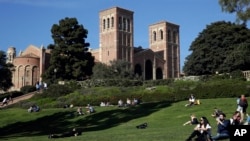The California Legislature on Thursday voted to give prospective college students more time to apply for two of the state's largest financial aid programs after a glitch in the federal government's application system threatened to block up to 100,000 people from getting help.
California had already extended the deadline for its financial aid programs from March 2 to April 2. On Thursday, the state Senate gave final approval to a bill that would extend it again until May 2. The bill now heads to Governor Gavin Newsom.
"Clearly, our students need our help," Assemblymember Sabrina Cervantes, a Democrat from Riverside who authored the bill, told lawmakers during a public hearing earlier this week.
California has multiple programs to help people pay for college. The biggest is the Cal Grant program, which gives money to people who meet certain income requirements. The state also has a Middle Class Scholarship for people with slightly higher incomes.
Students can apply for these state aid programs only if they first complete the Free Application for Federal Student Aid, commonly known as FAFSA.
This year, a computer glitch prevented parents from filling out the form if they did not have a Social Security number. That meant many students who are U.S. citizens or permanent residents but whose parents are not were blocked from completing the form and thus could not apply for California's aid programs.
California has a large population of adults who are living in the country without legal permission. The California Student Aid Commission, the state agency in charge of California's financial aid programs, estimates as many as 100,000 students could be affected by this glitch.
The U.S. Department of Education says it fixed the problem last week, but those families are now a step behind. Democrats in Congress raised alarms last month, noting that the delay could particularly hurt students in states where financial aid is awarded on a first-come, first-served basis, including Illinois, Kentucky, Missouri, Oregon and Texas.
Advocates fear that the chaos of this year's process could deter students from going to college at all, especially those for whom finances are a key part of the decision.
The computer glitch is just one part of larger problems affecting FAFSA.
The notoriously time-consuming form was overhauled in 2020 through a bipartisan bill in Congress. It promised to simplify the form, going from 100 questions to fewer than 40, and it also changed the underlying formula for student aid, promising to expand it to more low-income students.
But the update has been marred by delays, leaving families across the country in limbo as they figure out how much college will cost.
The form is typically available to fill out in October, but the Education Department didn't have it ready until late December. Even then, the agency wasn't ready to begin processing the forms and sending them to states and colleges, which only started to happen this month.
The problems appear to have already reduced California's application numbers. Through March 8, the number of California students who had completed FAFSA was 43% lower than it was at the same time last year.
"The data most concerning me seems to suggest that these drops are more acute at the schools that serve low-income students or large populations of students of color," Jake Brymner, deputy chief of policy and public affairs for the California Student Aid Commission, told lawmakers in a public hearing earlier this week.
The issue has caused problems for colleges and universities, too. The University of California and California State University systems both delayed their admissions deadlines because so many prospective students were having trouble with FAFSA.








